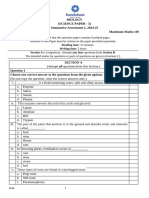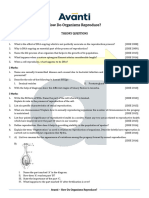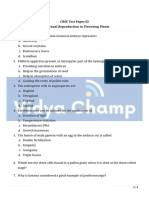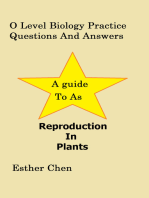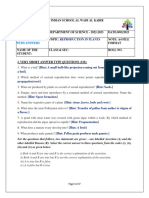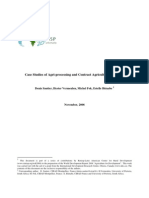0 ratings0% found this document useful (0 votes)
10 viewsSRIFP
SRIFP
Uploaded by
drlite0895Copyright:
© All Rights Reserved
Available Formats
Download as PDF, TXT or read online from Scribd
SRIFP
SRIFP
Uploaded by
drlite08950 ratings0% found this document useful (0 votes)
10 views3 pagesCopyright
© © All Rights Reserved
Available Formats
PDF, TXT or read online from Scribd
Share this document
Did you find this document useful?
Is this content inappropriate?
Copyright:
© All Rights Reserved
Available Formats
Download as PDF, TXT or read online from Scribd
Download as pdf or txt
0 ratings0% found this document useful (0 votes)
10 views3 pagesSRIFP
SRIFP
Uploaded by
drlite0895Copyright:
© All Rights Reserved
Available Formats
Download as PDF, TXT or read online from Scribd
Download as pdf or txt
You are on page 1of 3
Biology – 12th Jayshree Periwal High School
Chapter – 2 Sexual Reproduction in Flowering Plants
Very short answer type questions - (1 mark questions)
1. How many microsporangia are present in a typical anther of an angiosperm? [CBSE 2014]
2. An anther with malfunctioning tapetum often fails to produce viable male gametophytes. Give any one
reason. [CBSE 2010, 13]
3. Give an example of a plant which came into India as a contaminant and is a cause of pollen
allergy. [CBSE 2014]
4. Name the part of the flower which the tassels of the corn-cob represent. [CBSE 2014]
5. How many microspore mother cells would be required to produce one hundred pollen grains in a pollen-
sac? And why? [CBSE (F) 2013]
6. How is it possible in Oxalis and Viola plants to produce assured seed sets even in the absence of
pollinators? [CBSE (F) 2012]
7. State the function of filiform apparatus found in mature embryo sac of an angiosperm. [CBSE (F) 2014]
8. The microscopic pollen grains of the past are obtained as fossils. Mention the characteristics of the
pollen grains that makes it happen. [CBSE 2009]
9. Mention the pollinating agent of an inflorescence of small dull colored flowers with well exposed
stamens and large feathery stigma. Give any one characteristic of pollen grains produced by such
flowers. [CBSE 2009]
10. Name the type of flower, which favors cross pollination. [CBSE 2009]
11. The meiocyte of Rice has 24 chromosomes. How many chromosomes are present in its endosperm?
[CBSE 2009]
12. Name the part of flower that contributes to fruit formation in Strawberry and Guava respectively.
[CBSE 2009]
13. Banana is a true fruit but is also parthenocarpic fruit. Give reasons. [CBSE 2010]
Short answer type questions - (2 & 3 marks question)
1. It is said apomixis is a type of asexual reproduction. Justify. [CBSE 2019]
2. Draw a diagram of a mature microspore of an angiosperm. Label its cellular components only. [CBSE 2014]
3. Gynoecium of a flower may be apocarpous or syncarpous. Explain with the help of an example
each. [CBSE 2016]
4. How do flowers of Vallisneria get pollinated? [CBSE (F) 2013]
5. What is pollen-pistil interaction and how is it medicated? [CBSE (F) 2014]
6. Why are angiosperm anthers called dithecous? Describe the structure of its microsporangium. [CBSE 2014]
7. Name the organic materials the exine and intine of an angiosperm pollen grains are made up of. Explain
the role of exine. [CBSE 2014]
8. Name all the haploid cells present in an unfertilized mature embryo sac of a flowering plant. Write the
total number of cells in it. [CBSE 2013]
9. A pollen grain in angiosperm at the time of dehiscence from an anther could be 2-celled or 3-celled.
Explain. How are the cells placed within the pollen grain when shed at a 2-celled stage? [CBSE 2017]
10. Write the differences between wind-pollinated and insect-pollinated flowers. Give an example of each
type. [CBSE (F) 2014]
11. How does the study of different parts of a flower help in identifying wind as its pollinating agent? [CBSE
2014]
12. Mention two strategies evolved by flowers to prevent self-pollination. [CBSE 2014]
13. a. Can a plant flowering in Mumbai be pollinated by pollen grains of the same species growing in New
Delhi? Provide explanations to your answer.
b. Draw the diagram of a pistil where pollination has successfully occurred. Label the part involved in
reaching the male gametes to its desired destination. [CBSE 2017]
14. Out of many papaya plants growing in your garden, only a few bear fruits. Why? [CBSE 2016]
15. a. Name the organic material exine of the pollen grain is made up of. How is this material
advantageous to pollen grain?
b. Still it is observed that it does not form a continuous layer around the pollen grain. Give reason.
c. How are pollen banks useful? [CBSE 2016]
16. Double fertilisation is reported in plants of both, castor and groundnut. However, the mature seeds of
groundnut are non-albuminous and castor are albuminous. Explain the post fertilisation events that are
responsible for it. [CBSE 2015]
17. Mention the reasons for difference in ploidy of zygote and primary endosperm nucleus in an angiosperm.
[CBSE 2010]
18. A non biology person is quite shocked to know that apple is a false fruit, mango is a true fruit and banana
is a seedless fruit. As a biology student how would you satisfy this person? [CBSE 2015]
19. Explain any three advantages the seeds offer to angiosperms. [CBSE 2014]
20. Why are some seeds referred to as apomictic seeds? Mention one advantage and one disadvantage to a
farmer who uses them. [CBSE (AI, F) 2015]
21. State what is apomixis?Comment on its significance. How can it be commercially used? [CBSE 2015]
22. Some angiosperm seeds are said to be 'albuminous', whereas few others are said to have perisperm.
Explain each with the help of an example. [CBSE (F) 2014]
23. Suggest two advantages to a farmer for using apomictic seeds of hybrid varieties. [CBSE (F) 2015]
24. In the adjacent figure of a typical dicot embryo, label the parts 1, 2, and3. State the function of each of
the labelled part.
25. Explain with the help of a diagram the development of a mature embryo sac from a megaspore mother
cell in angiosperm. [CBSE 2009]
Long answer type questions - (5 marks questions)
1a. Draw a diagrammatic sectional view of a mature anatropous ovule and label the following parts:
(i) That develops into seed coat (outer and inner integuments)
(ii) That develops into an embryo after fertilisation (egg cell in egg apparatus)
(iii) That develops into an endosperm in an albuminous seed (secondary nucleus0
(iv) Through which the pollen tube gains entry into the embryo sac (micropyle)
(v) That attaches the ovule to the placenta (Funicle)
b. Describe the characteristic features of wind-pollinated flowers. [CBSE 2013]
2. A flower of tomato plant following the process of sexual reproduction produces 200 viable seeds. Answer
the following questions giving reasons:
a. What would have been the minimum number of ovules present in pre-pollinated pistil?
b. How many microspore mother cells would minimally be required to produce requisite number of
pollen grains?
c. How many pollen grains must have minimally pollinated the carpel?
d. How many male gametes would have been used to produce these 200 viable seeds?
e. How many megaspore mother cells were required in this process? [CBSE 2015]
3. a. When a seed of an orange is squeezed, many embryos, instead of one are observed. Explain how
it is possible.
b. Are these embryos genetically similar or different? Comment. [CBSE Delhi 2017]
4. a. Describe the endosperm development in coconut.
b. Why is tender coconut considered a healthy source of nutrition?
c. How are pea seeds different from castor seeds with respect to endosperm? [CBSE (AI) 2013]
5. Give reason why:
a. most zygotes in angiosperms divide only after certain amount of endosperm is formed.
b. groundnut seeds are exalbuminous and castor seeds are albuminous.
c. micropyle remains as a small pore in the seed coat of a seed.
d. integuments of an ovule harden and the water content is highly reduced, as the seed matures.
e. apple and cashew are not called true fruits. [CBSE (AI) 2011]
6. a. Draw a diagram of an enlarged view of T.S. of one microsporangium of an angiosperm and label
the following parts:
(i) Tapetum
(ii) Middle layer
(iii) Endothecium
(iv) Microspore mother cells
b. Mention the characteristic features and function of tapetum.
c. Explain the following giving reasons:
(i) Pollen grains are well preserved as fossils.
(ii) Pollen tablets are in use by people these days.
7 a. Describe any two devices in a flowering plant which prevent both autogamy and geitonogamy.
ovule of an angiosperm. [CBSE(AI) 2018]
You might also like
- Sexual Reproduction in Flowering Plants PyqDocument24 pagesSexual Reproduction in Flowering Plants PyqSoumya Ranjan NaikNo ratings yet
- Class Xii Biology Cbse Board Questions ChapterwiseDocument43 pagesClass Xii Biology Cbse Board Questions ChapterwiseDiksha TNo ratings yet
- Xii Bio 2008-19 DR Manish KumarDocument18 pagesXii Bio 2008-19 DR Manish Kumarnegi94534No ratings yet
- Sexual Reproduction in Flowering Plants Previous Year QPDocument3 pagesSexual Reproduction in Flowering Plants Previous Year QPAngelina BennyNo ratings yet
- CH 2 Rep. in Flowering Plants 2023 - 24 WSDocument3 pagesCH 2 Rep. in Flowering Plants 2023 - 24 WSArchfab73No ratings yet
- Xii Biology Lesson1 Reproduction Part2 Module1Document2 pagesXii Biology Lesson1 Reproduction Part2 Module1rarerojiNo ratings yet
- Xii Bio PyqDocument27 pagesXii Bio PyqKavy ShahNo ratings yet
- Bio (QB)Document63 pagesBio (QB)nivas1806No ratings yet
- Sexual Reproduction in Flowering PlantsDocument3 pagesSexual Reproduction in Flowering Plantsvaibhavrajsingh56No ratings yet
- Revision Sexual Repro Updated - 015735Document5 pagesRevision Sexual Repro Updated - 015735George SkariahNo ratings yet
- Class 12 Biology Chapter 2 Important Questions Sexual Reproduction in Flowering PlantsDocument42 pagesClass 12 Biology Chapter 2 Important Questions Sexual Reproduction in Flowering PlantspranathigoraNo ratings yet
- Bio Boards 04-11-2024 CHAPTER 1 REVISION MATERIALDocument1 pageBio Boards 04-11-2024 CHAPTER 1 REVISION MATERIALneet6731No ratings yet
- Chapter 2 PracticeDocument20 pagesChapter 2 PracticetNo ratings yet
- All Document Reader - 1708528159903Document79 pagesAll Document Reader - 1708528159903Efrin SnowNo ratings yet
- CLASS XII QUESTION BANK BiologyDocument88 pagesCLASS XII QUESTION BANK Biologyshaunak krithishNo ratings yet
- 12-BIOLOGY QUESTION BANK (With Value Based Questions) - 1Document33 pages12-BIOLOGY QUESTION BANK (With Value Based Questions) - 1venkatesh kumarNo ratings yet
- Bio_Chapterwise_Imp_Quest_XII (1)Document40 pagesBio_Chapterwise_Imp_Quest_XII (1)spaceastronautissNo ratings yet
- Previous Year QP - 1. Reproduction in OrganismsDocument1 pagePrevious Year QP - 1. Reproduction in OrganismsAngelina BennyNo ratings yet
- Cbtaqp2 1Document7 pagesCbtaqp2 1bwqbmm5sxyNo ratings yet
- XII B Bio - Chapterwise - Imp - Ques Pages DeletedDocument3 pagesXII B Bio - Chapterwise - Imp - Ques Pages Deletedpiyushsingh15507No ratings yet
- Sexual Reproduction in Flowering PlantsDocument3 pagesSexual Reproduction in Flowering Plantssyed ayaaanNo ratings yet
- 12 Reproiduction in PlantsDocument4 pages12 Reproiduction in PlantsJaskirat SinghNo ratings yet
- CLASS - XII - BIOLOGY - MCQS - Chapter 2 Sexual Reproduction in Flowering PlantsDocument9 pagesCLASS - XII - BIOLOGY - MCQS - Chapter 2 Sexual Reproduction in Flowering PlantsJijendarNo ratings yet
- CH 1 BioDocument6 pagesCH 1 BioTy TyNo ratings yet
- Delhi Public School, Jodhpur: Term Exam - I (2016 - 17) Class - XII Subject - Biology Time: 3 Hours M.M.: 70Document2 pagesDelhi Public School, Jodhpur: Term Exam - I (2016 - 17) Class - XII Subject - Biology Time: 3 Hours M.M.: 70Tushar RajNo ratings yet
- (A) (B) (C) (D)Document3 pages(A) (B) (C) (D)mf974431No ratings yet
- 12 Biology Imp ch2 2Document9 pages12 Biology Imp ch2 2priyanjalaproNo ratings yet
- Biology Holiday Home Work Class 12 MedDocument8 pagesBiology Holiday Home Work Class 12 Medsargun5650No ratings yet
- Class XII - Biology 3Document8 pagesClass XII - Biology 3Rajesh Kumar ParidaNo ratings yet
- GR12 - Chapter 2 - Sexual Reproduction in Flowering PlantsDocument3 pagesGR12 - Chapter 2 - Sexual Reproduction in Flowering PlantsNameNo ratings yet
- Xamidea Sexual Reproduction in Flowering PlantsDocument31 pagesXamidea Sexual Reproduction in Flowering PlantsShireen SuhailNo ratings yet
- Class Xii Biology Questions ChapterwiseDocument42 pagesClass Xii Biology Questions Chapterwiseashok pradhanNo ratings yet
- IMP BIO Ch1Document3 pagesIMP BIO Ch1mohammadhassan697790No ratings yet
- Thane - SA1 - GR 6 - Bio - PP1 - QP - 2024-25Document7 pagesThane - SA1 - GR 6 - Bio - PP1 - QP - 2024-25Dragon SlayerNo ratings yet
- April MT IiDocument2 pagesApril MT Iipraveengr1290No ratings yet
- 1Bwe1qmUcFFLW5z1ElVmDocument55 pages1Bwe1qmUcFFLW5z1ElVmnsumatha85No ratings yet
- 12 Biology Sexualreproductioninfloweringplant tp01Document5 pages12 Biology Sexualreproductioninfloweringplant tp01Dec veenNo ratings yet
- Sample Paper 7Document13 pagesSample Paper 7pavanshankarrps2021No ratings yet
- 12TH CH-2 AssignmentDocument3 pages12TH CH-2 AssignmentTanvi SinghNo ratings yet
- QB A1bDocument2 pagesQB A1bjayashree krishnaNo ratings yet
- Ch38 StudyDocument2 pagesCh38 Study오승혜No ratings yet
- How Do Organisms Reproduce Previous Years QuestionsDocument2 pagesHow Do Organisms Reproduce Previous Years Questionsashasuyal295No ratings yet
- X Cbse ReproductionDocument1 pageX Cbse ReproductionPriyaprasad PandaNo ratings yet
- Yk Q4 DW Ro ZFP3 MSzqiq JZDocument18 pagesYk Q4 DW Ro ZFP3 MSzqiq JZSudip DasNo ratings yet
- SEXUAL REPRODUCTION IN FLOWERING PLANTS (1)Document1 pageSEXUAL REPRODUCTION IN FLOWERING PLANTS (1)arnabhazra842No ratings yet
- Revision Test QP Flowering Plants 2024-25Document2 pagesRevision Test QP Flowering Plants 2024-25sujal.singh18decNo ratings yet
- Marks Wise Questions CH-1Document27 pagesMarks Wise Questions CH-1lakshshah5116No ratings yet
- Hsslive-2-B - Sexual Reproduction in F.P, Previous Yr HSE N Model QuestionsDocument3 pagesHsslive-2-B - Sexual Reproduction in F.P, Previous Yr HSE N Model Questionskr2654438No ratings yet
- LN 2 - Sexual Reproduction in Flowering PlantsDocument20 pagesLN 2 - Sexual Reproduction in Flowering PlantsZara KNo ratings yet
- Self Notes Touching The Best Point From Every ChapterDocument11 pagesSelf Notes Touching The Best Point From Every Chaptersantunaskar948No ratings yet
- CBSE Test Paper 02 Ch-2 Sexual Reproduction in Flowering PlantsDocument4 pagesCBSE Test Paper 02 Ch-2 Sexual Reproduction in Flowering PlantsShahid ansariNo ratings yet
- 12 THDocument4 pages12 THguptaamrita5335No ratings yet
- WORKSHEET 3 TOPIC - Sexual ReproductionDocument7 pagesWORKSHEET 3 TOPIC - Sexual ReproductionhemasenthilvelanNo ratings yet
- XII MATHS FINALDocument232 pagesXII MATHS FINALdrashutoshnayakNo ratings yet
- KRM Public School: Periodic Assessment (April - 2021)Document4 pagesKRM Public School: Periodic Assessment (April - 2021)GaneshNo ratings yet
- Biology Class 10 - Most Important QuestionsDocument12 pagesBiology Class 10 - Most Important QuestionsAditi PandyaNo ratings yet
- Good NotesDocument12 pagesGood Notessantunaskar948No ratings yet
- Summer Vacation Homework 12 Class BiologyDocument5 pagesSummer Vacation Homework 12 Class Biologykilleryt032No ratings yet
- 2014 Sex Rep QuestionsDocument2 pages2014 Sex Rep QuestionsWakeupto RealityNo ratings yet
- O Level Biology Practice Questions And Answers: Reproduction In PlantsFrom EverandO Level Biology Practice Questions And Answers: Reproduction In PlantsRating: 3 out of 5 stars3/5 (2)
- Lettuce FarmingDocument6 pagesLettuce FarmingRoosel Fevy Joy D. BalolongNo ratings yet
- Jtam Ema PediyanaDocument9 pagesJtam Ema PediyanaHikmah ArmyandiNo ratings yet
- Engineering Properties of Residual Soils in Jurong FormationDocument77 pagesEngineering Properties of Residual Soils in Jurong Formationzhuo fungNo ratings yet
- Highway DrainageDocument9 pagesHighway DrainagePatrick AlfredNo ratings yet
- Test Result For Density of Soil and Soil Aggregates in Place by Nuclear Method (Shallow Depth) Astm D6938Document1 pageTest Result For Density of Soil and Soil Aggregates in Place by Nuclear Method (Shallow Depth) Astm D6938Mohamed BarakatNo ratings yet
- Week 11. Compaction ExamplesDocument5 pagesWeek 11. Compaction ExamplesJennevive Micabalo CabugsaNo ratings yet
- University of PeradeniyaDocument6 pagesUniversity of Peradeniyanaveen daluwattaNo ratings yet
- Class 8 Crop Production Eureka Plus Science Exercise AnswerDocument5 pagesClass 8 Crop Production Eureka Plus Science Exercise AnswerabhimanusksNo ratings yet
- Zal Agri SbaDocument16 pagesZal Agri SbaDexter TorringtonNo ratings yet
- 9497975-Class 7 - Science - Reproduction in Plants - WS With Ans - PreetiDocument7 pages9497975-Class 7 - Science - Reproduction in Plants - WS With Ans - PreetiSonaliNo ratings yet
- CUET 2023 SyllabusDocument113 pagesCUET 2023 SyllabusDivyanshi PareekNo ratings yet
- Soal Latihan Descriptive TextDocument3 pagesSoal Latihan Descriptive TextSaera LyraiNo ratings yet
- Soil Fertility and Nutrient ManagementDocument2 pagesSoil Fertility and Nutrient ManagementRajat Raghorte100% (1)
- StudyDocument5 pagesStudyImagineprincess wolfNo ratings yet
- CDFDocument76 pagesCDFmishra.nagendra7311No ratings yet
- Sexual Reproduction in Flowering PlantsmcqsDocument26 pagesSexual Reproduction in Flowering PlantsmcqsM.Tharun KumarNo ratings yet
- Terra Preta - Model of A Cultural Technique - Schmidt-2011Document10 pagesTerra Preta - Model of A Cultural Technique - Schmidt-2011Bruno ImbroisiNo ratings yet
- AEN3412 Examination 2016-2017Document6 pagesAEN3412 Examination 2016-2017Mwizukanji NakambaNo ratings yet
- Ganja Mission PossibleDocument46 pagesGanja Mission PossibleAbhishek KumarNo ratings yet
- Corn Crop Nutrition ProgramDocument1 pageCorn Crop Nutrition ProgramYvonneNo ratings yet
- Borehole ID: BH-Z1-002: Client: ProjectDocument2 pagesBorehole ID: BH-Z1-002: Client: Projectjoynul abedenNo ratings yet
- Case Studies of Agri-Processing and Contract Agriculture in AfricaDocument30 pagesCase Studies of Agri-Processing and Contract Agriculture in AfricaAngel MondolokaNo ratings yet
- BEST-2K Method For Characterizing Dual-PermeabilitDocument20 pagesBEST-2K Method For Characterizing Dual-PermeabilitchetanNo ratings yet
- What Is A NurseryDocument28 pagesWhat Is A NurseryHumayne SutherlandNo ratings yet
- Ele Hort 368 Full Printed Notes PDFDocument48 pagesEle Hort 368 Full Printed Notes PDFrushikesh KanireNo ratings yet
- Tabel Plan VS AktualDocument1 pageTabel Plan VS AktualOna PetrusNo ratings yet
- Summary Chapter 3Document7 pagesSummary Chapter 3Arrissa F1052No ratings yet
- BonsaiDocument8 pagesBonsaiAllanNo ratings yet
- Crop Sci Post Test IIDocument12 pagesCrop Sci Post Test IITeam Agri CulturaNo ratings yet
- Soil Structure As An Indicator of Soil FunctionsDocument16 pagesSoil Structure As An Indicator of Soil FunctionsSergio Andrés Quilaguy DíazNo ratings yet

































